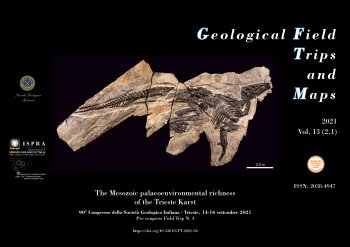
Volume 13 (2.2)/2021
The Mesozoic palaeoenvironmental richness of the Trieste Karst
90° Congresso della Società Geologica Italiana - Trieste, 14-16 settembre 2021. Pre congress Field Trip T4
DOI: https://doi.org/10.3301/GFT.2021.06 - Pages: 1-40
Lorenzo Consorti (1,3), Deborah Arbulla (2), Lorenzo Bonini (3), Simone Fabbi (1), Federico Fanti (4), Marco Franceschi (3), Gianluca Frijia (5) & Gian Andrea Pini (3)
(1) - Geological Survey of Italy (ISPRA), 00144 Rome, Italy.
(2) - Civic Museum of Natural History, 34139 Trieste, Italy.
(3) - Department of Mathematics and Geosciences, University of Trieste, 34128 Trieste, Italy.
(4) - Dipartimento di Scienze Biologiche, Geologiche e Ambientali, Alma Mater Studiorum, University of Bologna, 40126 Bologna, Italy. (5) - Dipartimento di Fisica e Scienze della Terra. University of Ferrara, 44122 Ferrara, Italy.
Corresponding Author e-mail address: lorenzo.consorti@isprambiente.it
(2) - Civic Museum of Natural History, 34139 Trieste, Italy.
(3) - Department of Mathematics and Geosciences, University of Trieste, 34128 Trieste, Italy.
(4) - Dipartimento di Scienze Biologiche, Geologiche e Ambientali, Alma Mater Studiorum, University of Bologna, 40126 Bologna, Italy. (5) - Dipartimento di Fisica e Scienze della Terra. University of Ferrara, 44122 Ferrara, Italy.
Corresponding Author e-mail address: lorenzo.consorti@isprambiente.it
Abstract
The Mesozoic of the Trieste Karst is part of the 90th Congress of the Italian Geological Society, Trieste Italy, 2021. The guide aims at documenting selected outcrops located on the Karst plateau where fossil richness is related to particular carbonate platform facies associations to highlight the area as an important archive for marine and continental palaeodiversity. The Trieste Natural History Museum holds the most important collection of Late Cretaceous fossils, including exceptionally preserved dinosaurs (Tethyshadros insularis), reptiles, land plants, crustaceans, and fishes of the Villaggio del Pescatore geosite. At the Villaggio del Pescatore geosite fossil-rich carbonate rhythmites are spectacularly exposed on quarried surfaces. At Cava Romana it is possible to observe the Upper Cretaceous rudist-rich platform facies of the "Aurisina limestone". The Slivia quarry exposes a Cretaceous palaeokarst deposit made of large limestone blocks. The Cenomanian peritidal carbonate succession of the Moschenizza hill shows m-thick rudist limestone beds, and cm-thick dark-coloured, muddy wackestones sporadically rich in fossil land plants like Frenelopsis.
Keywords
Upper Cretaceous, shallow-water carbonates, limestone breccia, rhythmites, foraminifera, dinosaurs, rudist, paralic environments.
